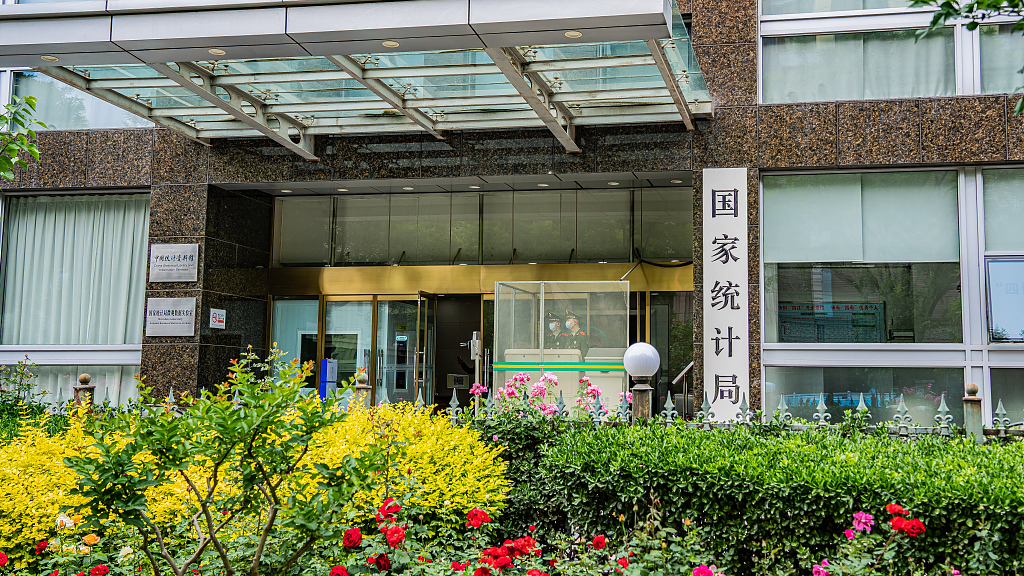
The National Bureau of Statistics, Beijing, China, May 12, 2022. /CFP
The National Bureau of Statistics, Beijing, China, May 12, 2022. /CFP
Editor's note: Liu Chunsheng is an associate professor at the Central University of Finance and Economics. The article reflects the author's opinion, and not necessarily the views of CGTN.
On July 15, 2022, the National Bureau of Statistics released macroeconomic data for the first half of the year. China's economy grew by 2.5 percent year-on-year. In the first half of the year, China's economy faced enormous challenges, especially since April, the successive COVID-19 outbreaks in Shanghai and Beijing have had a huge impact on the national economy. Since May, as the epidemic has been gradually controlled, major economic indicators have begun to improve, but it will take time for them to fully stabilize.
The target of 5.5 percent economic growth set by the national Two Sessions this year is a tall order at present. Looking forward to the second half of the year, the challenges facing China's economy are still huge and the situation is still complex.
The first is how to balance epidemic prevention and economic growth. There is still great uncertainty in terms of the spread of the epidemic, and it is difficult to make accurate predictions about where or when the virus will hit, which poses a threat on the behavior of all kinds of market players. In addition, the epidemic has consumed a lot of reserves, the ability of residents to afford is declining, and people's willingness to consume is dropping.
China is also facing an extremely complex external environment, and the world political and economic situation varies. The Russia-Ukraine crisis sees little chance to be ended in the short term. The geopolitical conflict has intensified, accompanied by the increasing global inflationary pressure and the intensifying risk of the food and energy crisis, also the increasing uncertainty of China-U.S. relations.
Recently, British Prime Minister Boris Johnson resigned, followed by former Japanese Prime Minister Shinzo Abe's death, and then Sri Lanka went bankrupt and the Italian government is at risk of collapse. The complexity and severity of the external environment has increased significantly. The return of capital to the United States caused by the Fed's interest rate hike will have a great impact on Europe in turmoil and emerging markets with fragile economies.
The global withdrawal from loose monetary policy may trigger an economic recession, and China's exports will face a downward trend in external demand. On the other hand, the outward transfer of production and supply chains, which has been going on for several years, will also have a great impact on China's foreign trade.

A woman shops at a supermarket in Congtai District of Handan, north China's Hebei Province, July 9, 2022. /Xinhua
A woman shops at a supermarket in Congtai District of Handan, north China's Hebei Province, July 9, 2022. /Xinhua
Amid an economic downturn, financial risks are accumulating. Recently, some real estate buyers in China's Xi'an, Changsha, Wuhan, Zhengzhou and other cities took the initiative to suspend mortgage payments due to delayed deliveries of presold homes, and issued a notice to the bank of such actions.
Among the reasons given in the mortgage suspension notice, the main causes are that bank supervision is not in place and the loans to the real estate companies are issued in violation of regulations. The mortgage suspension has a great impact on the real estate and financial industries, and efforts should be made to avoid a financial crisis that affects economic stability.
Market confidence and expectations have not yet recovered. At present, the orders received by enterprises are obviously insufficient. Due to rising costs, small and micro enterprises are going through a tough time, making a great impact on expectations. Some enterprises delay or reduce their production expansion plans. Enterprises are reducing new jobs and expanding layoffs. The unemployment rate in urban surveys in May is still high, and the employment pressure of youth groups is even greater.
In the second half of the year, policy makers need to introduce more measures to stabilize economic growth.
In terms of monetary policy, there is still a lot of room for the current prudent one. The central bank should support financial institutions to carry out consumption credit business through interest discounts. Consumption should be encouraged through appropriate government subsidies and financial institutions to grant low interest or interest-free consumer credit.
On fiscal policy, in addition to continuing tax cuts and fee reductions to cut costs for small and micro enterprises, central and local governments should increase infrastructure investment to grow domestic demand.
In the long run, the key is to cultivate new drivers of sustained growth, including improving innovation capacity, boosting the digital transformation of manufacturing, expanding middle-income groups, and better engagement with the agricultural population.
(If you want to contribute and have specific expertise, please contact us at opinions@cgtn.com. Follow @thouse_opinions on Twitter to discover the latest commentaries on CGTN Opinion Section.)

